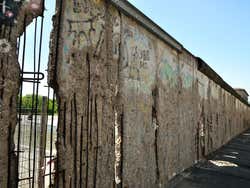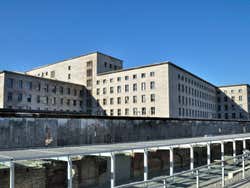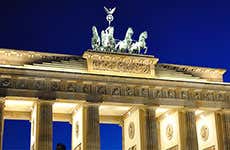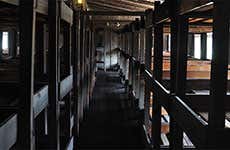
Berlin Wall
The Berlin Wall divided the capital of Germany in two for 28 years. Learn the details of its construction, fall and past. Discover where the remains of the Wall still stand in Berlin.
The construction and fall of the Berlin Wall are two crucial 20th-century episodes. The Berlin Wall divided the city in two for nearly thirty years, separating families and friends.
History of the Wall
At the end of World War II, Berlin and Germany were divided into four zones; the American sector, the British sector, the French sector and the Soviet sector. The deteriorating relationship between the Allies and the Soviet Union worsened year after year to the point that two currencies, two political ideals, and finally, two Germanies were enforced.
On 23 May 1949, the Western Allies (USA, France, Britain) signed an agreement establishing the Federal Republic of Germany (West Germany). On 7 October 1949, the Soviet zone established the German Democratic Republic (East Germany).
Berlin was divided into two areas and the Allies and the Soviet Union created 81 checkpoints between the two sections of the city.
Construction of the Wall
Up to 1961, nearly three million people immigrated to the flourishing West Berlin due to the collapsing Soviet Economy.
East Germany was unhappy with the high percentage of inhabitants (especially those with higher educations) leaving the socialist state. To prevent more people from leaving, a provisional wall was built in the early hours of 13 August 1961, and 69 checkpoints closed, leaving 12 in the whole city still functioning.
The next morning, the authorities had placed a provisional barbed wire 155 km long that separated East Berlin from West Berlin. The means of transportation could no longer cross the border.
During the following days, a brick wall was built between the whole border. The houses that were on the frontier were evicted.
Over the following years, many people tried to escape to West Berlin. The authorities eager to make people stay, expanded the wall thus increasing its surveillance.
The Berlin Wall became a concrete wall 3.5 to 4 meters high. The concrete slabs were filled with steel wires to make it more resistant. The top of the wall had a hemisphere shape, so it would be difficult to hold onto.
The “death strip” was a space established between the Berlin Wall and a new fence placed further into East Berlin. It had a ditch, a road for military vehicles, an alarm system, automatic weapons, guard towers and guards accompanied by guard dogs 24 hours a day. It was practically impossible to escape to the other side, nevertheless, East Germans never stopped trying.
In 1975, the “death strip” covered 43 kilometres of the Wall. The rest of the Wall was protected by fences.
Crossing to the West
Between 1961 and 1989 over 5,000 people tried to cross the Wall and over 3,000 of them were detained. Approximately 100 people died trying to escape. The last person shot dead was on 5 February 1989.
The Checkpoint Charlie Museum reflects the most curious stories of how people tried to cross the border.
Fall of The Berlin Wall
When Communism fell in Hungary in 1989, the electric fence between the country and Austria was removed. It was the first step for the fall of the “Iron Curtain”, as it caused massive demonstrations in Alexanderplatz. On 9 November 1989, East Germany’s government opened all the checkpoints.
On the same day, thousands of East Germans gathered at the Berlin Wall to cross to the other side and they were not stopped, so there was a huge exodus.
The next day, the Berlin Wall started to be knocked over.
Once the borders were reopened, family members and friends who had been separated for 28 years finally came together.
Where to See the Remains of the Wall
The longest part of the Berlin Wall that is still standing is called the East Side Gallery. Visitors can walk along the 1.3 kilometre-long barrier that is beautifully decorated with paintings that reflect several events related to the Wall.
Near Checkpoint Charlie is the documentation center called “Topography of Terror”, which houses parts of the Berlin Wall.
Guided Tour
Learn more about the Berlin Wall on our guided tour of Berlin during the Cold War.



